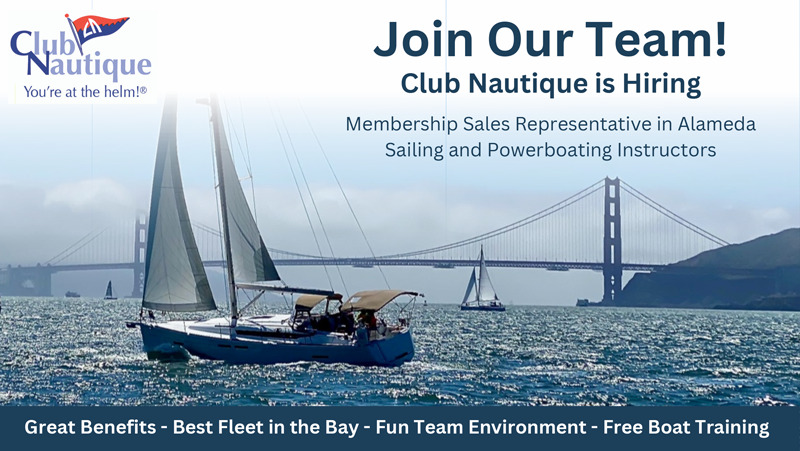
Randall Reeves and Harmon Shragge Near Homer, Alaska, and the End of a First Leg
“After three years biding her time in a San Francisco Bay marina, Moli took her departure from the Golden Gate Bridge at 4 p.m. on August 31. Destination: Homer, Alaska via a westerly rounding of the North Pacific High. Aboard: two crew, Randall, as one might expect, and Harmon.”
And after more than 20 days at sea, vacillating winds, the minor mending of equipment, clouds and sunsets, multiple blogs, excellent food and a few days spent thrashing around on a drogue during multiple gales, Randall Reeves, Harmon Shragge and the 41-ft aluminum sloop Moli are nearing Homer, Alaska, and the conclusion of the first stage of their “wrong way,” multi-leg circumnavigation of the Americas.
After completing the Figure 8 Voyage in 2019 — which was preceded by an aborted attempt but full circumnavigation starting in 2017 (and which is still the name of Reeves’ blog) — there is something quite comforting to those of us here at Latitude 38 knowing that Moil is once again eating up miles daily, and that Reeves’ prose is once again on the internet. (Shragge has his own blog as well, and it’s fantastic.)
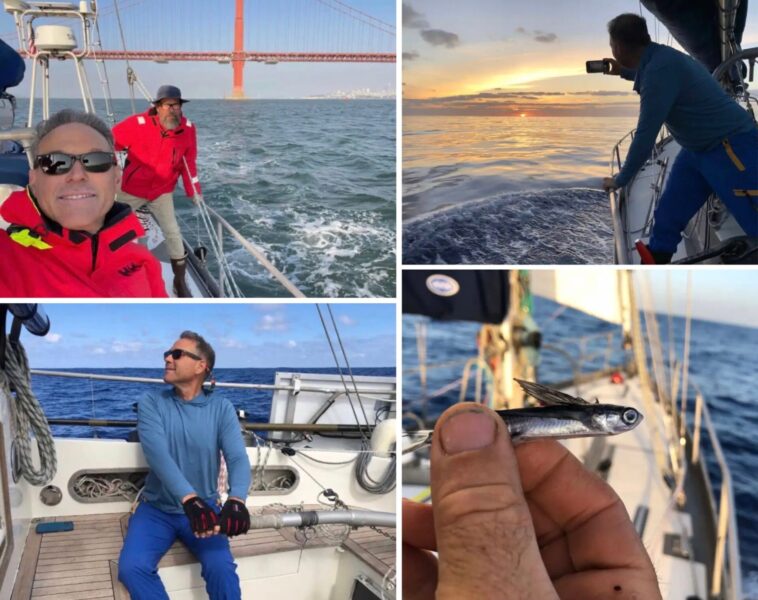
Reeves wrote on his blog that for months, he’d planned to “run in the NE trades to about the longitude of Kauai — not the latitude, not that far south, but likely that far west — followed by a slow transit around the outside of the North Pacific High and thence on to Homer. That was the strategy.” Rather than finding a single high to circumvent, however, what lay before him, Shragge and Moli was a minefield. “There is no one High to transit. What is here is rather a collection of Highs banging around the middle of the Pacific like squabbling minor gods.” Moli weaved her way through windless blobs, motoring often.
Around September 7, about Day 8 of the passage and “abruptly at 10 a.m., a cloud wall ended in a terminal squall, a leaden explosion of atomic proportions, and with that the day cleared and the wind filled in. We sailed close reaching to the west for two hours, Mo almost bounding, but the day couldn’t take the pressure and our wind collapsed by mid afternoon.”
Break out the swim trunks.
“Having brought Mo to a standstill, I suggested we go for a swim,” Reeves wrote. “I have never had the courage to take the mid-ocean plunge when alone, but Harmon needed no prodding, and when he was back aboard, I followed. Water temp: 72. A bracing splash and then delicious floating atop 15,000 feet (height of Mt. Whitney) of clear-blue glass. Two zebra striped fishes rose from beneath Mo’s mighty protection to see if I bore treats and then hurried back into her shadow. I swam around Mo for a time … but not too far, home port being some 900 miles to the east.”
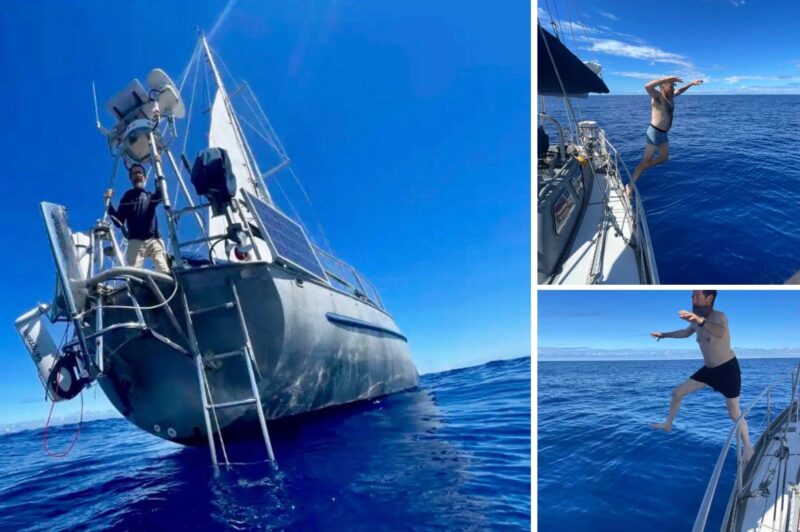
By Day 10, as they were seeing 25-30 knots of wind and three reefs, the dichotomy of Moli’s crew revealed itself. “[Harmon’s] ocean crossings have been with Clipper races and a Fastnet aboard a Volvo sled, boats that are driven to the max at all times. ‘How do you know when to reef?’ asked Harmon. Apparently, the boats he’s sailed have strict protocols; at X knots, reef. I shrugged. You feel it. You can feel when a boat is over pressed.”
Reeves and Shragge met through the Farallon Patrol (and the nonprofit Point Blue), the volunteer flotilla that ferries scientists and supplies to the marine sanctuary. “Harmon and I got to talking about future projects at a Farallon Patrol dinner. His was to circumnavigate the Americas, but he lacked the right vessel. I said I knew of a vessel that might do, but that I’d been around the Americas. ‘What about going the other way around?’ he asked.
“And so here we are, pounding into a North Pacific head sea.”
Pounding away at seas and on the keyboard, Reeves wrote on September 11, “There is a truism in passage making that it — where ‘it’ is a place holder for trying weather-related moments of all kinds — only happens at night. That this is a truism should not dissuade of its veracity.” That night saw winds drop and reefs reluctantly and belatedly shaken out, shortly before the wind and reefs returned.
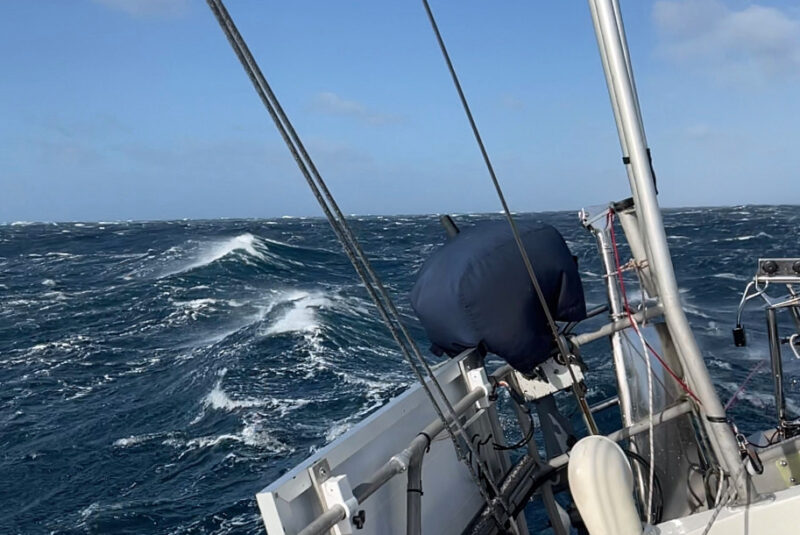
Moli nearly lost her Watt&Sea hydrogenerator, which has since been repaired and replaced. Around Day 16 of the passage (about five days ago), a dark-colored blob apporoached. “‘About five years ago our fall weather started getting worse and worse,’ Adam, a professional fisherman friend of mine from Homer [said]. So then it seems only right that we would see at least one good blow.”
Prior to then, the wind had been good. “Strong SW winds gave us a run of 164 very wet, very rough but very happily accepted miles. The day before, 150 fast, close-reaching miles. Today [September 14] I’ve budgeted for 140 miles but am betting on 150+, close hauled. This will put us within about 140 rhumb-line miles of Kodiak by the time [a] low arrives. That may be the closest we get.”
Break out the drogue.
“There is something disquietingly final about riding a drogue. You are, in a sense, anchored to the sea, and like being anchored to a good holding bottom in a storm, you are there for the duration. For the JSD [Jordan Series Drogue], duration is usually when winds come back down to 25 knots or less. So, there is no escaping the drogue until the event concludes, except that it be cut free, an expensive proposition.”
After some adjustments (and the catastrophic loss of a pan of quinoa and a chocolate cake with a pudding center), “Mo rode well. In the thick black of night, I could feel the braking of the drogue as she was pushed forward by a sea. She felt solid, steady; yet any movement in the cabin required two hands and planning or else one was thrown around mercilessly.”
And that’s where we must leave this particular update. Reeves’ last post was on Sunday, and Shragge’s was on Tuesday. “The conditions for these gales were not that bad,” Shragge said. “Waves rarely got over 20 feet, and the cross swell was manageable.”
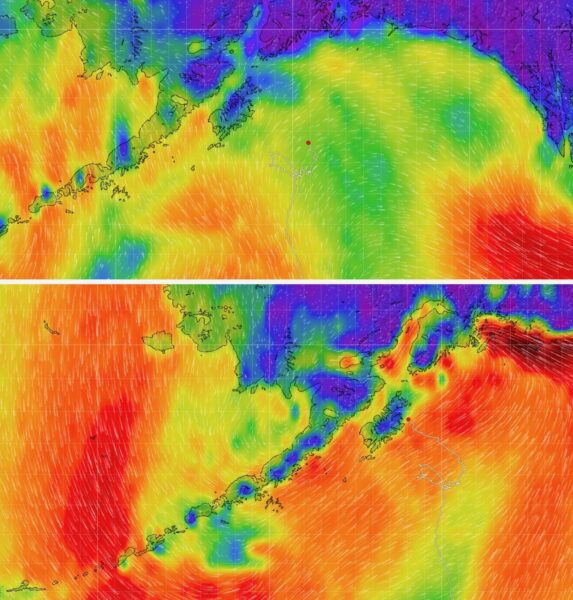
About deploying the drogue, Reeves wondered, “Did the strategy work? Yes. As of this writing, we are a mere 35 miles from our position at noon on Saturday; compare 160 if we’d run off. Was it worth it? The cost has been high: a solar panel modulator and probably a single side band radio lost to wet; the dodger, blown out by the pooping sea. Not to say that sailing would have been cost free.”
We will update you once the duo has reached their Leg 1 destination of Homer, Alaska.
Wooden Boats for Veterans Sails Aboard ‘Matthew Turner’
On Saturday, the Wooden Boats for Veterans organization gathered in Sausalito for a day out on the water. Hosted by Call of the Sea aboard the Matthew Turner, local veterans were invited for a two-part outing. Part 1 began in the morning, for a modified aloft program.
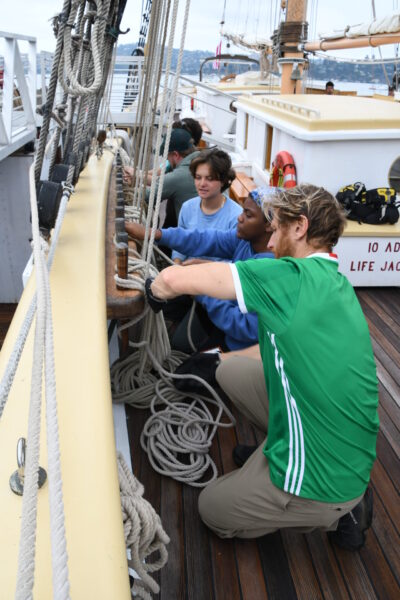
After the egress tour and a safety chat, Call of the Sea crew divided the group into three smaller groups for a proper training session on running Matthew Turner. Crew demonstrated communication, line handling, and best practices for going aloft; guests were given the task of manning the main staysail station.
There were veterans from all branches of the military, and other local veterans’ community groups joined for Part 2 — the sailing part! Using their new knowledge, the group assisted the tall-ship crew once the boat was off the dock and underway for a trip out into the Central Bay.
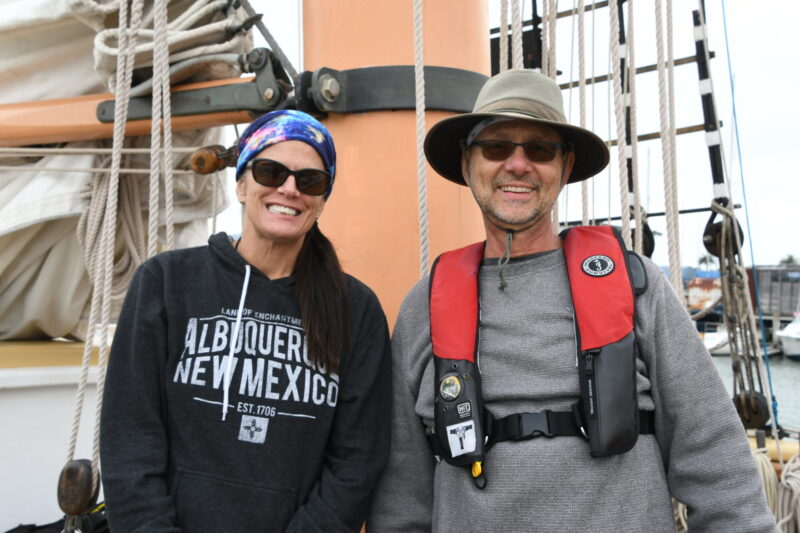
For Lindsay Remer, an explosive ordnance-disposal technician for 12 years who’s been medically retired since 2013, working on restoring a wooden boat is a welcome source of meaningful work. “The hands-on training on the boat — I no longer feel useless,” she explains.
“My job was the tip of the spear, a kind of poster-child job in Afghanistan. I did two tours in Afghanistan, six years overseas for mainbasing, and four years on the Central Coast. Then they tell you you’re too broken to continue, so you go from having this really important job to nothing. Wooden Boats gives a purpose — not just getting on the boat, but I also enjoy the volunteer work on Clover because you know you’re doing something important. When it’s done, you’re helping other vets.”
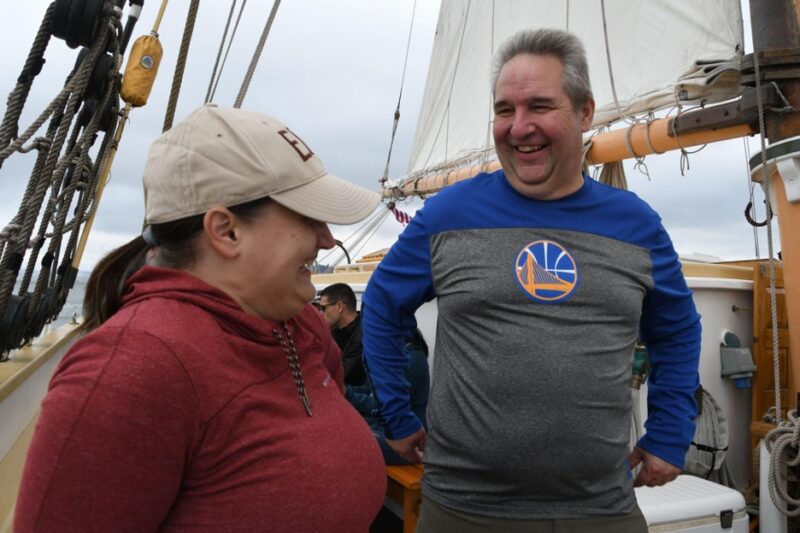
Remer is referring to WBFV’s current project, the restoration of the 1938 68-ft gaff-rigged sloop that was commandeered in 1939 by the Royal Navy. The restoration project incorporates marine science and the VA’s therapeutic activities — meaning lots of sanding, scraping and varnishing.
For Remer, it’s a chance to get back out in public in a safe environment. “I have a fairly high rating for PTSD, so getting out and doing something like this, it’s freeing in a way. I have been so isolated during COVID, and like, I never really know how to respond to [civilian] people when we talk. Like I’ll say that I’ve gotten blown up twice, and everyone’s like, ‘WHAT?’” says Remer. “But with the vets, they all know what it’s like without saying.”
Remer says that since being medically retired, she felt she’d collapsed in on herself. But what WBFV offers is a special kind of therapy for veterans who are dealing with complicated reentry to civilian life. From struggling to relate with friends and family, to dealing with severe depression and PTSD, or just needing to rebuild community, recreational therapy is a tailored approach to finding help and support for veterans.
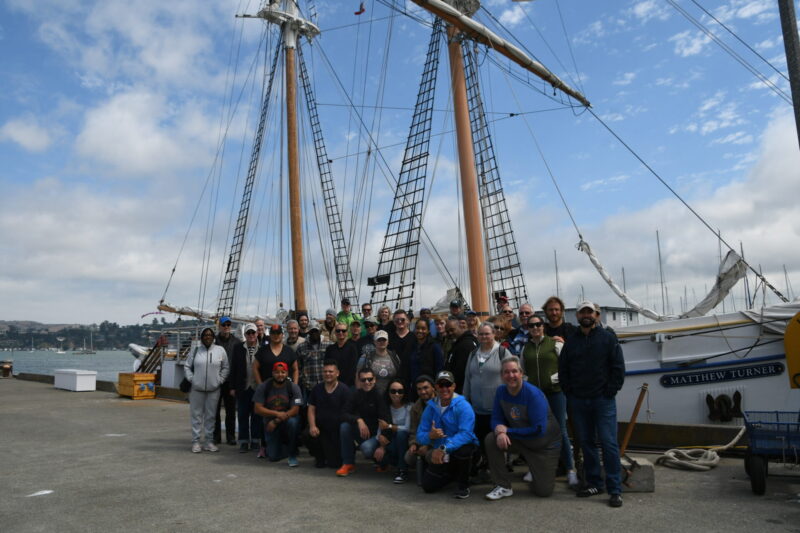
James Johnson, sailing director of WBFV, says there’s something transformative about being out on the water. “There’s something that Terry Moran, our founder, said — it’s very philosophical. He said: ‘When you’re out on a boat, ideally a wooden boat in saltwater, with a company of other like-minded vets, your problems diminish to their proper proportions.’
“It’s just like Terry always says,” comments Johnson: “‘Just add water.'”
A longer story about WBFV is coming in a print issue of Latitude 38 — keep a weather eye out!
Club Nautique Is Hiring!
Time for Our Annual Pilgrimage to the Annapolis Sailboat Show
For many different subsets of the human population, there are wide varieties of sacred destinations: the Vatican, Mecca, the Western Wall, the Taj Mahal, Disneyland and Burning Man. For sailors in the US, it’s the Annapolis Sailboat Show. In its more than 50-year history since starting in 1970, the show has been the North Star for sailors seeking the ultimate shoreside sailing buzz.
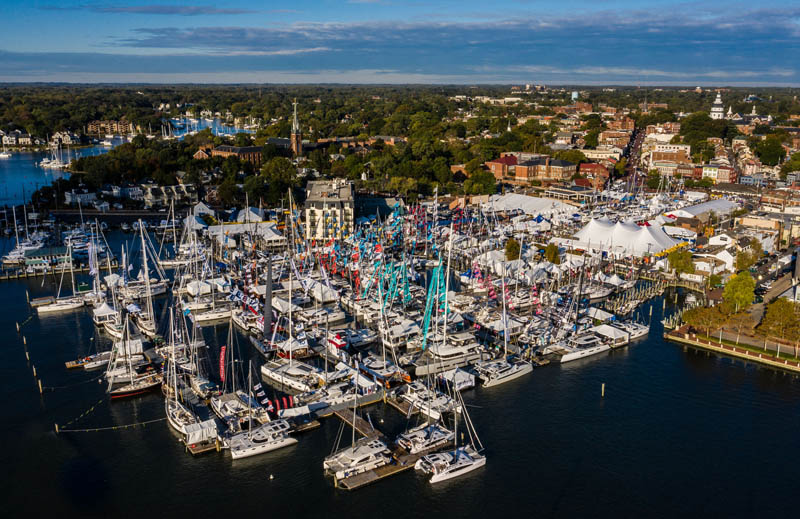
The four-day show will be held October 12-15 in beautiful downtown Annapolis. It’s easy to write “beautiful downtown … anywhere” when you’re talking about a destination, but for sailors, downtown Annapolis is truly a classic, historical East Coast destination. The show takes over the downtown area, with the boats and tents squeezed in and around the inner harbor. The brick sidewalks and buildings are alive with sailors, and with bars overflowing during and after the show. McGarvey’s, not far from the show gates, is a favorite.
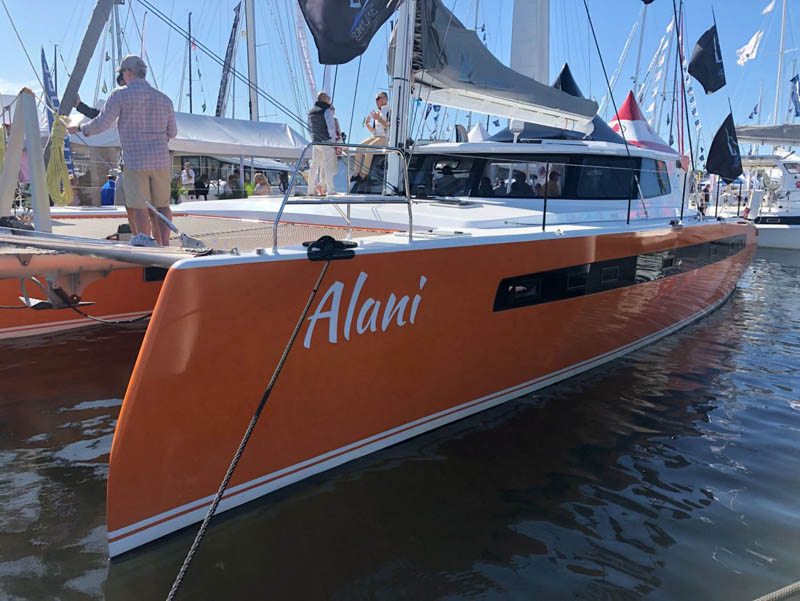
We’ve made the pilgrimage for over 30 years to see boats and gear, but mostly to see people. The show attracts all the major players in the sailing business and their principals. It’s a great place to catch up with the global sailing community. You’ll see friends from California, but you’re also able to talk with business owners from Europe, Asia and the East and West coasts.
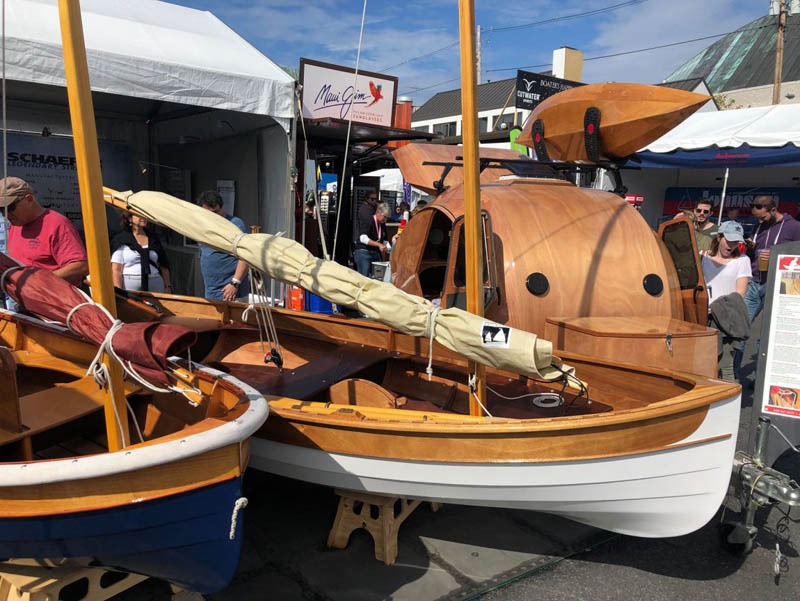
Annapolis is also the capital of Maryland and has a rich history to explore outside the show’s gates. The US Naval Academy is adjacent to the show and worth visiting. The Annapolis Yacht Club is right next door as well, and the weather in October is usually superb, though conditions may vary. (It’s been hot and humid during boat shows, and also cold and rainy, but it’s generally pleasant and always worth it.) It is also around the time of the Chesapeake Fall Series racing, as well as when a lot of Caribbean-bound cruisers are passing through.
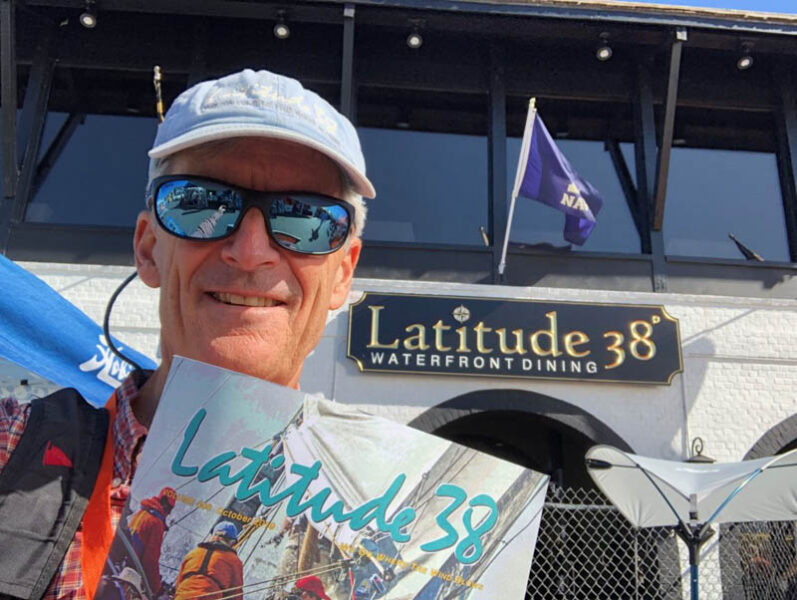
The most convenient airport is the BWI (Baltimore Washington), a relatively easy 25 miles from downtown. The show’s popularity makes lodging tricky, but with enough searching, you’ll find something.
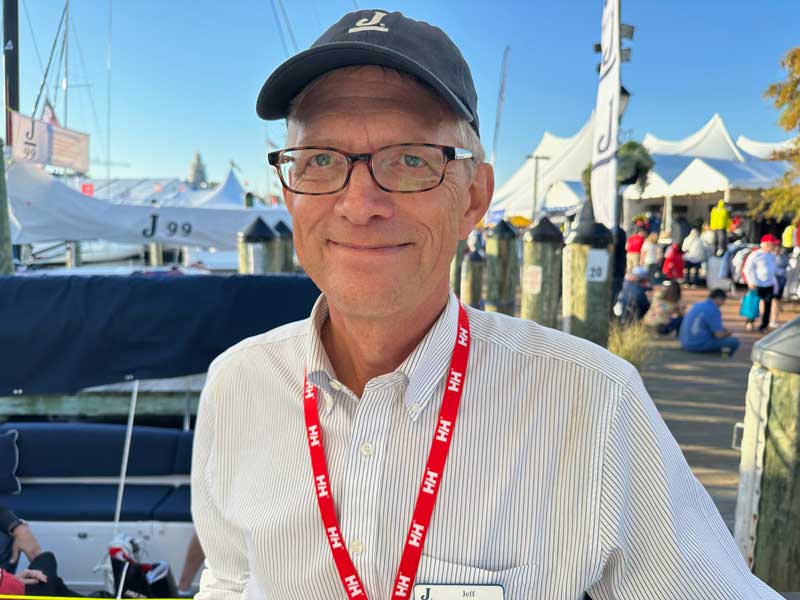
Of course, the main draw is the exhibitors. There are more sailboats, more multihulls, more charter companies and more gear and equipment manufacturers than you’ll find at any other sailboat show in the US. And it is all sailing! No powerboats allowed. This is your crowd.
Walking the docks, you’ll run into sailors and businesses from California. You can also take courses from Cruisers University or find time for a test sail. It’s a great place to puzzle out watermakers, batteries, communications, wind vanes or other gear and equipment decisions you are trying to assess.
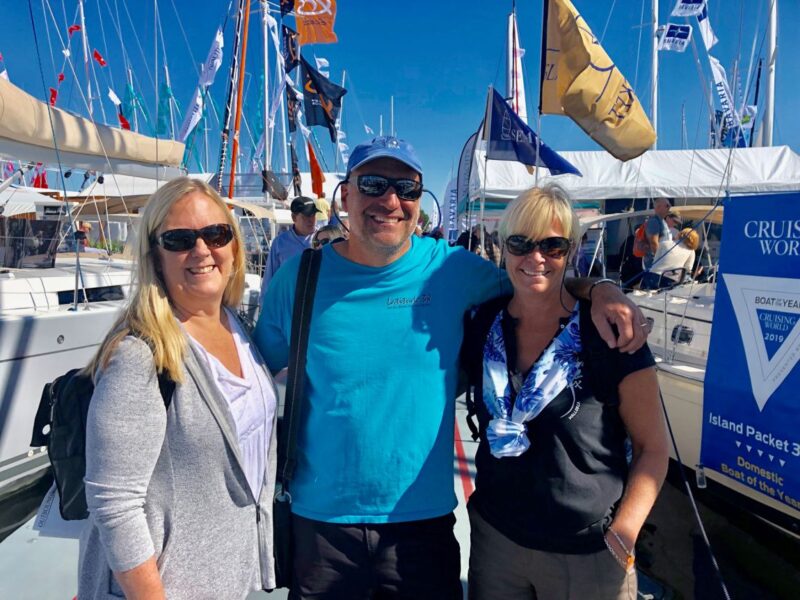
It’s a great show, great time of year and great town. We look forward to the Annapolis Boat Show every year, and will hope to see you there too.
Jeanne Socrates Is Still Singlehanding Across the Oceans
We just heard from Encinal Yacht Club staff commodore Bill Nork, who sent in a couple of photos and wrote in to say, “I had the distinct pleasure of having dinner with Jeanne Socrates at Mezzogiorno restaurant in Bucerias on Banderas Bay, Mexico, in May. Jeanne was leaving the next day, singlehanding her 38-ft sloop Nereida to French Polynesia and beyond. Jeanne is now 81, and holds the world record for being the oldest woman to circumnavigate nonstop, which she did at age 77. There were eight of us at dinner, but Jeanne was seated right next to me, so I got to ask her lots of questions. She is charming, funny and very down to earth.”
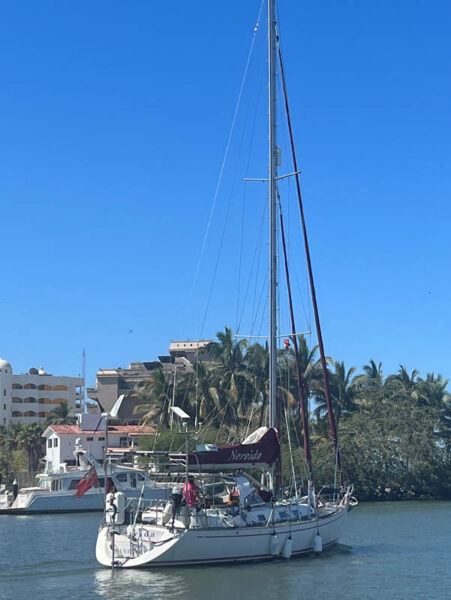
“I asked her if she had sailed around Cape Horn, and she answered with a twinkle, ‘Oh yes, three times.’ She added that the worst weather she ever encountered was off the coast of Oregon!”
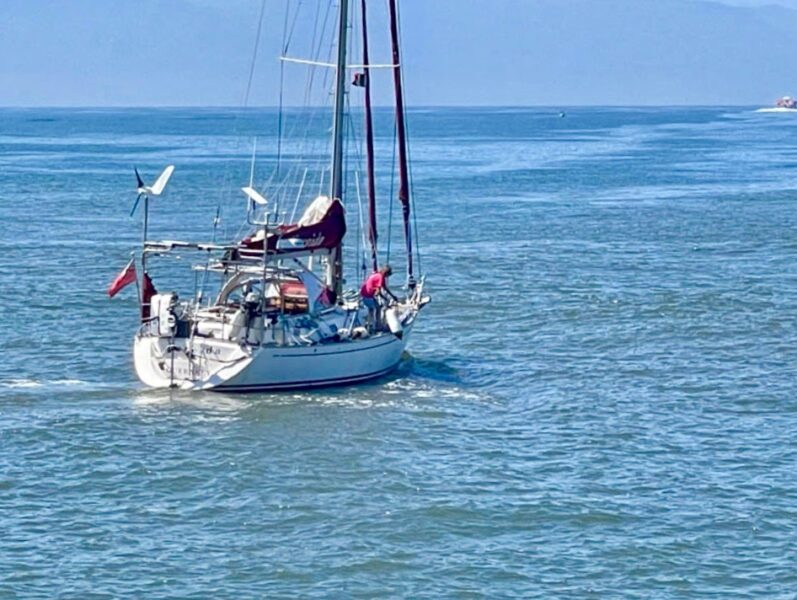
“I inquired whether she wore a PFD when sailing, and she said, ‘Rarely.’
“We finished dinner at about 9:30 p.m. One of our party invited everyone back to his gorgeous Hylas 54 at Paradise Village Marina for a nightcap of some special black-label tequila. My wife and I asked Jeanne, with whom we were sharing a taxi, if she wanted to have some tequila or be dropped off at her boat, as we knew she was leaving on her long solo sail the next morning, and she said, without hesitation, ‘Oh, tequila; I’m a party girl!'”
We checked in with Jeanne’s blog to find that she did arrive in Anaho Bay, northeast of Nuku Hiva Island, on May 28 after a 25-day voyage from La Cruz, Mexico. Taiohae is, of course, the main harbor of the island of Nuku Hiva with its dramatic, high, steep-sided volcanic mountains, and is the capital of the Marquesas. Jeanne was then headed to the Tuamotus, Tahiti, Huahini, Raiatea and Taha’a. She wrote, “I could have easily spent more time in all the very different parts of French Polynesia — but my visa only gave me three months so, on September 4, I set sail for the Cook Islands and then Tonga.”

Her latest update has her heading out the very narrow entrance/exit from Aitutaki Harbor, where she managed some repairs including reef lines and a pesky alternator bracket. From there, she’s headed to Vava’u, Tonga, possibly via Beveridge Reef. With four solo circumnavigations and, at 81, Jeanne Socrates (Good Jibes podcast here) continues to amaze and inspire sailors while continuing to enjoy, party and share her passion for cruising with everyone she meets.
Enjoy Downwind Sailing With Walder Boom Brake
The innovative Walder boom brake — active safety at sea. www.boom-brake-walder.com.

